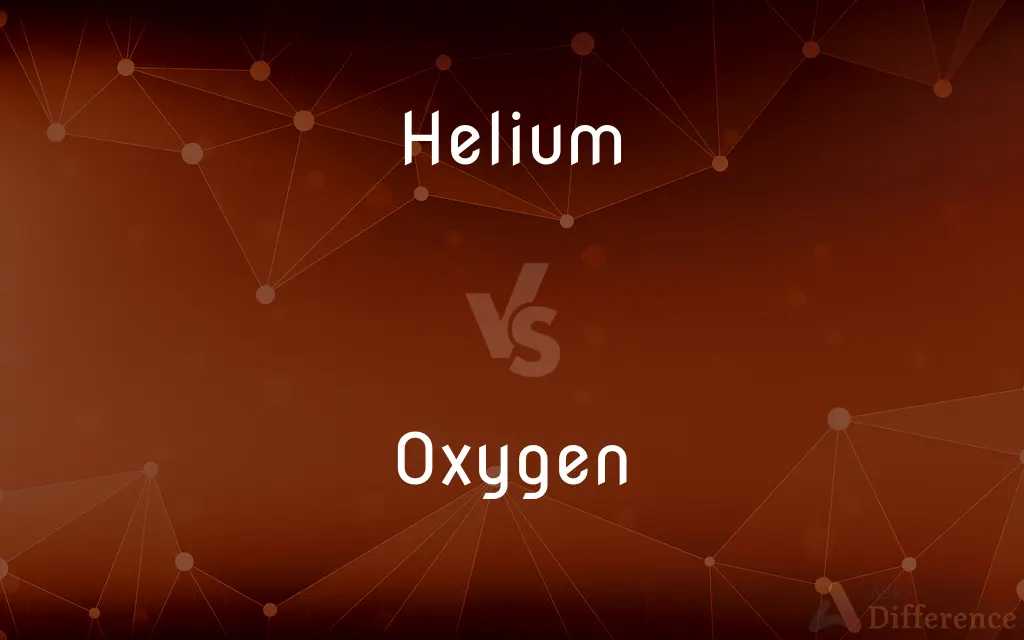Helium vs. Oxygen — What's the Difference?

Difference Between Helium and Oxygen
ADVERTISEMENT
Compare with Definitions
Helium
Helium (from Greek: ἥλιος, romanized: helios, lit. 'sun') is a chemical element with the symbol He and atomic number 2. It is a colorless, odorless, tasteless, non-toxic, inert, monatomic gas, the first in the noble gas group in the periodic table.
Oxygen
Oxygen is the chemical element with the symbol O and atomic number 8. It is a member of the chalcogen group in the periodic table, a highly reactive nonmetal, and an oxidizing agent that readily forms oxides with most elements as well as with other compounds.
Helium
A colorless, odorless inert gaseous element occurring in natural gas and with radioactive ores. It is used as a component of artificial atmospheres and laser media, as a refrigerant, as a lifting gas for balloons, and as a superfluid in cryogenic research. Atomic number 2; atomic weight 4.0026; boiling point -268.9°C; density at 0°C 0.1785 gram per liter. See Periodic Table.
Oxygen
A colourless, odourless reactive gas, the chemical element of atomic number 8 and the life-supporting component of the air.
An oxygen supply
If breathing stops, there is no oxygen getting to the brain and the cells begin to die
Hydrogen and carbon in the fuel combine with the oxygen in the air to form carbon dioxide and water
Helium
(uncountable) The second lightest chemical element (symbol He) with an atomic number of 2 and atomic weight of 4.002602, a colorless, odorless and inert noble gas. Category:en:Helium
ADVERTISEMENT
Oxygen
A nonmetallic element constituting 21 percent of the atmosphere by volume that occurs as a diatomic gas, O2, and in many compounds such as water and silica, and in iron ore. It combines with most elements, is essential for plant and animal respiration, and is required for nearly all combustion. Ozone, O3, is an allotrope of this element. Atomic number 8; atomic weight 15.9994; melting point -218.79°C; boiling point -182.9°C; gas density at 0°C 1.429 grams per liter; valence 2. See Periodic Table.
Helium
(countable) A form or sample of the element.
Oxygen
The chemical element (symbol O) with an atomic number of 8 and relative atomic mass of 15.9994. It is a colorless and odorless gas. Category:en:Oxygen
Helium
An inert, monoatomic, gaseous element occurring in the atmosphere of the sun and stars, and in small quantities in the earth's atmosphere, in several minerals and in certain mineral waters. It is obtained from natural gas in industrial quantities. Symbol, He; atomic number 2; at. wt., 4.0026 (C=12.011). Helium was first detected spectroscopically in the sun by Lockyer in 1868; it was first prepared by Ramsay in 1895. Helium has a density of 1.98 compared with hydrogen, and is more difficult to liquefy than the latter. Chemically, it is an inert noble gas, belonging to the argon group, and cannot be made to form compounds. The helium nucleus is the charged particle which constitutes alpha rays, and helium is therefore formed as a decomposition product of certain radioactive substances such as radium. The normal helium nucleus has two protons and two neutrons, but an isotope with only one neutron is also observed in atmospheric helium at an abundance of 0.013 %. Liquid helium has a boiling point of -268.9° C at atmospheric pressure, and is used for maintaining very low temperatures, both in laboratory experimentation and in commercial applications to maintain superconductivity in low-temperature superconducting devices. Gaseous helium at normal temperatures is used for buoyancy in blimps, dirigibles, and high-altitude balloons, and also for amusement in party balloons.
Oxygen
Molecular oxygen (O2), a colorless, odorless gas at room temperature, also called dioxygen.
Helium
A very light colorless element that is one of the six inert gasses; the most difficult gas to liquefy; occurs in economically extractable amounts in certain natural gases (as those found in Texas and Kansas)
Oxygen
(medicine) A mixture of oxygen and other gases, administered to a patient to help them breathe.
Oxygen
(countable) An atom of this element.
Oxygen
(figurative) A condition or environment in which something can thrive.
Silence is the oxygen of shame.
They hoped to starve the terrorists of the oxygen of publicity.
Oxygen
A colorless, tasteless, odorless, gaseous element of atomic number 8, occurring in the free state in the atmosphere, of which it forms about 23 per cent by weight and about 21 per cent by volume, being slightly heavier than nitrogen. Symbol O. Atomic weight 15.9994.
Oxygen
Chlorine used in bleaching.
Oxygen
A nonmetallic bivalent element that is normally a colorless odorless tasteless nonflammable diatomic gas; constitutes 21 percent of the atmosphere by volume; the most abundant element in the earth's crust
Share Your Discovery

Previous Comparison
Cleave vs. Cling
Next Comparison
Bobbin vs. Coil














































